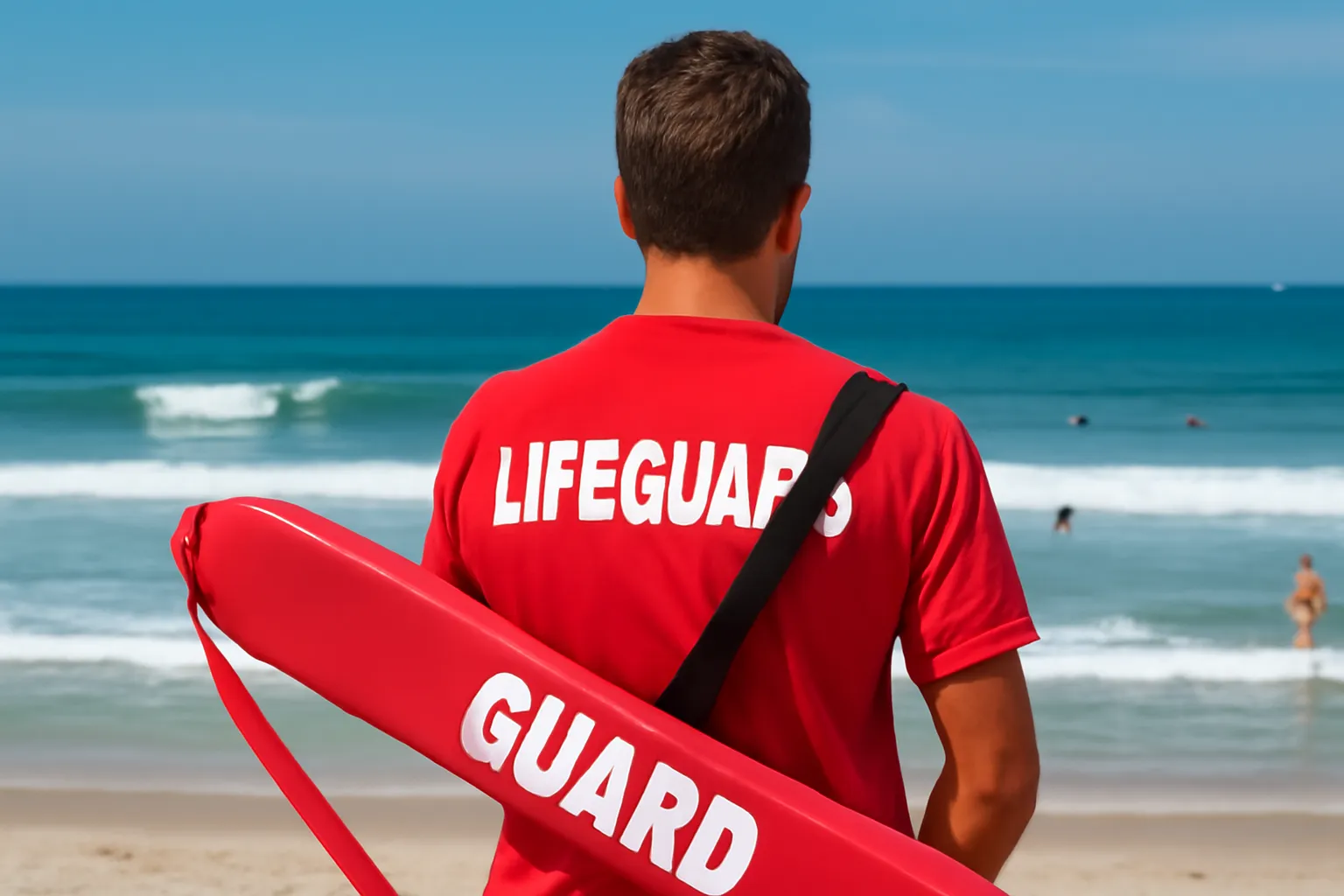Table of Contents
Lifeguards are an essential part of ensuring safety at swimming pools, beaches, and water parks. They keep a close watch on swimmers, ensuring everyone is safe and assisting when necessary. The color red, a signature of lifeguard uniforms, plays a pivotal role in their visibility and impact. But what’s behind this seemingly simple color choice?
In this article, we’ll explore the top 10 reasons why lifeguards wear red, backed by research in color psychology, visibility studies, and the history of lifeguard uniforms.
Why Do Lifeguards Wear Red?
Lifeguards wear red because it ensures high visibility, signals urgency in emergencies, evokes trust, and has historical significance as a color of safety. The red uniform helps lifeguards stand out against the water, enhancing their ability to respond quickly and professionally.
The Power of Color Psychology
Colors are not just about aesthetics; they have profound psychological effects on the human brain. The color red, in particular, is linked to excitement, energy, and alertness. Red is often seen as a signal of danger or urgency, which makes it the perfect color for lifeguards. When people see red, they subconsciously associate it with a need to pay attention, whether it’s due to an emergency or a sign of importance.
Lifeguards need to be easily spotted in situations where seconds matter. The vibrant red color signals to those around them that the lifeguard is not just part of the crowd, but someone who should be watched carefully. This is why the color red has been chosen to convey both authority and readiness for action.
Visibility: The Lifeguard’s Key to Being Seen
A lifeguard’s ability to stand out in a crowded, often chaotic environment is paramount. Whether at a busy pool or a crowded beach, red ensures that lifeguards can be easily identified, even from a distance. Red is one of the most visible colors to the human eye, and its use in lifeguard uniforms ensures that they are not easily missed, especially in emergencies.
When swimming or sunbathing, people may not always be looking around for lifeguards. The stark contrast of red against the background of blue water or sandy beaches makes it impossible for lifeguards to be overlooked. This high visibility can be the difference between life and death in an emergency.
Red and Emergency Situations
The color red is not just used in lifeguard uniforms; it is also associated with emergency services like fire trucks, ambulances, and emergency signs. This is not by chance – red triggers a response in people, urging them to act quickly. It’s the color of alertness and urgency. Lifeguards wear red uniforms to communicate that they are the first line of defense in an emergency. The use of red signals to swimmers and bystanders indicates that if something goes wrong, immediate help is available.
In a scenario where seconds matter, the sight of a red uniform can help people react faster, whether it’s for evacuating the area, assisting a distressed swimmer, or alerting others to the emergency. Red has become synonymous with rapid response and emergency action.
Contrast with Water and Natural Elements
The primary task of a lifeguard is to oversee swimmers in an environment where visibility can sometimes be challenging, especially in large bodies of water. Red stands out sharply against the colors of the water, such as blue, green, and grey, as well as the surrounding landscape. This stark contrast ensures that lifeguards remain visible no matter the environmental conditions.
The bright red color of their uniforms makes it much easier to spot them, even when the water is murky or when the lifeguard is far from the shore. The ability to easily spot a lifeguard is not only important for the safety of swimmers but also ensures that bystanders and fellow lifeguards can quickly locate them in times of need.
Historical Roots of Lifeguard Uniforms
The history of lifeguard uniforms dates back to the early 20th century, when the need for formal beach safety began to rise. Initially, lifeguards wore plain clothing, but as the role became more official, uniforms were introduced. Over time, red emerged as the color of choice, not only for its visibility but also due to its historical association with warnings and safety.
Before lifeguards were formally trained, red was already widely used in signaling danger, particularly on road signs, train stations, and military uniforms. As lifeguarding became more structured, it made sense to adopt this color for the uniforms, ensuring that lifeguards would be both visible and recognizable as individuals responsible for the safety of others.
Lifeguard Uniforms as a Symbol of Authority
Lifeguard uniforms serve more than just a practical purpose – they are also a symbol of authority. The color red plays a significant role in commanding attention and respect. When a lifeguard wears a red uniform, they are easily identified as the person in charge of overseeing safety. The presence of a red uniform immediately conveys authority, which is vital in an emergency.
The uniform also serves as a reminder to the public that there are trained professionals available to help in any emergency. It encourages trust and confidence in lifeguard services, which is essential for public safety.
Read also: Why Are Airfares So Expensive
Standardization Across Lifeguard Services
Red is now the standard color for lifeguards worldwide. Whether at a beach, public pool, or water park, you’ll often see lifeguards dressed in red. This standardization ensures that lifeguards are easily identifiable, regardless of location. It helps build a global recognition system where the public knows that someone wearing red is there for their safety.
Standardizing the color also simplifies communication between lifeguards in different regions and countries. Whether it’s at an international event or a different city, a red uniform signals the same message: the lifeguard is responsible for the safety of swimmers.
Trust and Public Perception
Lifeguards are tasked with a significant responsibility: protecting the lives of people in the water. The color red plays a role in establishing trust with the public. When swimmers see a lifeguard in red, they know that this person is there to protect them. This sense of security is essential for the lifeguard’s effectiveness. If swimmers trust that the lifeguard is trained and capable, they are more likely to follow safety guidelines, which reduces the likelihood of accidents.
Red uniforms help enhance public perception, reassuring beachgoers that they are in good hands. The lifeguard becomes a beacon of safety, someone who can be relied upon in an emergency.
Durability and Practicality of Red Fabric
Lifeguards work long hours, often in harsh conditions, including direct sunlight, water exposure, and physical activity. For this reason, red fabric is chosen for its durability and comfort. Red uniforms are made from materials that not only stand out but also withstand the wear and tear of lifeguard duties.
The material used in lifeguard uniforms is designed to be both breathable and resistant to fading from sun exposure, ensuring that the lifeguard remains visible throughout their shift without compromising comfort.
Branding and Recognition
In many cases, lifeguard uniforms are part of a larger branding effort. Public and private lifeguard services often adopt a specific color scheme to distinguish themselves. Red uniforms are an effective tool for branding lifeguard services because they make the lifeguards stand out to the public. This recognition is vital for both safety and branding purposes.
For lifeguard services, a red uniform is a symbol of professional and reliable service. It helps them maintain a consistent and recognizable image, which can build trust with the community they serve.
Final Words
The choice of red for lifeguard uniforms is not arbitrary. Red is a color that combines visibility, authority, and urgency, which makes it ideal for lifeguards. From its psychological effects on human behavior to its practical benefits in ensuring safety, red plays a crucial role in the lifeguard’s job.
Whether it’s signaling an emergency or simply making lifeguards visible in a crowded environment, the color red has become a symbol of safety and trust for swimmers around the world.
People also ask
Why do lifeguards wear red specifically?
Lifeguards wear red because it is highly visible, associated with urgency, and stands out in emergencies, helping lifeguards be easily spotted in busy environments.
What are some alternative colors used for lifeguard uniforms?
While red is the most common, some lifeguards may wear yellow, orange, or even neon colors to enhance visibility, depending on local preferences and environmental conditions.
Does the color red impact lifeguard behavior?
Yes, the color red signals urgency and authority, encouraging lifeguards to remain alert and ready to act swiftly during emergencies.
Why is visibility so crucial for lifeguards?
Visibility ensures that lifeguards can be seen by swimmers, beachgoers, and other lifeguards, which is essential for safety, especially in large, crowded environments.
Are there different uniforms for lifeguards in different regions?
Yes, lifeguards may wear different uniforms based on regional preferences or specific safety guidelines, though red remains the standard in many places.

